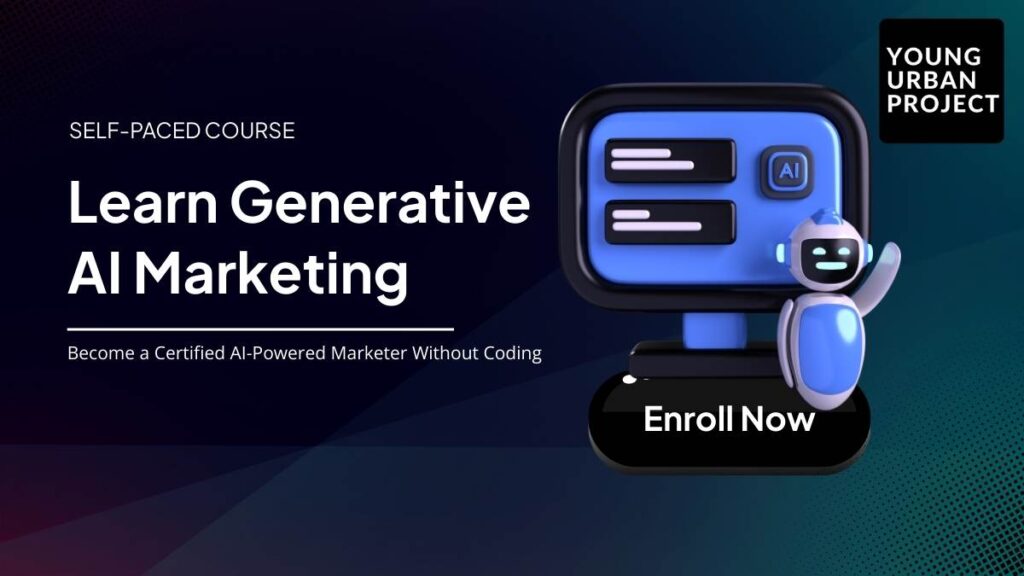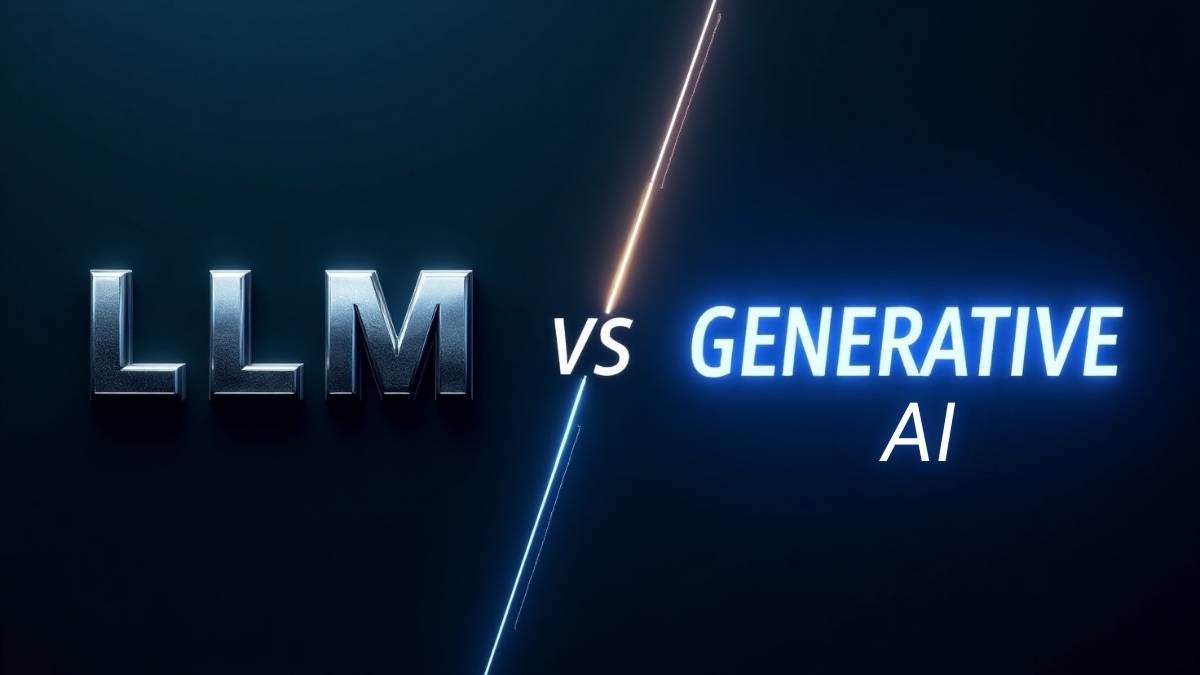Artificial Intelligence (AI) has changed a lot in recent years. We started with basic computer programs that just followed rules. Now we have smart systems that can talk, write, create pictures, and even make music.
Table of Contents
In 2025, you need to know what kind of AI tool you’re using. People often talk about LLMs (Large Language Models) and Generative AI. Many people mix up these terms. They might sound alike, but they are different things.
In this blog, we’ll explain everything in plain terms:
- What is generative AI?
- What are large language models (LLMs)?
- LLM vs Generative AI
- What can you use them for?
- And when should you pick one over the other?
Let’s begin.
What Is Generative AI?
Generative AI makes new things like text, pictures, music, videos, or computer code. The word “generative” means it can create stuff.
Old AI systems could only follow rules or pick from answers someone already wrote. But generative AI can make brand new things. It learns by studying many examples, just like how we learn by watching and doing.
How Does Generative AI Work?
Generative AI uses deep learning. These systems study huge amounts of information. Then they find patterns in all that data.
After training, these AI systems can take your request (like a question or a photo) and make something new based on what they learned.
One type is called GANs (Generative Adversarial Networks). These work like two AIs competing with each other. One tries to make something fake (like a fake picture), and the other tries to spot the fake. As they keep working, both get better, and the fake things start looking very real.
Types of Generative AI
There are many kinds of generative AI tools for different types of content:
- Text: Chatbots like ChatGPT or Claude
- Pictures: Tools like Midjourney or DALL·E
- Sound: AI that makes music or voice recordings (like ElevenLabs)
- Videos: Tools that make or change videos based on your instructions
- Computer Code: AI that helps write programs (like GitHub Copilot)
To sum up: Generative AI is a big group of AI models that make new content across different types of media.
Also Read: Generative AI vs Predictive AI
What Are Large Language Models (LLMs)?
LLMs, or Large Language Models, are a special type of generative AI model. These focus only on one thing: human language.
They’re trained to understand and generate text, things like articles, conversations, summaries, translations, and more.
What Makes LLMs Special?
LLMs are built using a special design called transformer architecture. This helps them understand the meaning of words in context, not just one word at a time, but how words connect in a sentence.
They also need to be trained on huge text datasets (think: books, websites, documents). The more data, the smarter they get.
Once trained, these AI systems can:
- Write blog posts
- Answer questions
- Summarize documents
- Translate languages
- And even have conversations
Some Popular LLMs You Might Know
- GPT-4 (by OpenAI), used in ChatGPT
- Claude (by Anthropic)
- PaLM (by Google)
- LLaMA (by Meta)
All of these models are powerful, but they focus mainly on language understanding and generation, not images, music, or video.
How LLMs Work (In Simple Terms)
Let’s break this down into a super simple version:
- Learning from Language:
First, the model is trained on a large number of text documents, like Wikipedia, books, and websites. - Breaking Words Into Pieces:
Words are broken down into smaller parts, called tokens. For example, “generative” might be split into “gen-”, “era-”, “tive”. - Understanding Meaning with Embeddings:
These tokens are turned into numbers. The AI uses those numbers to understand what each word means and how it relates to other words. - Paying Attention to Context:
LLMs use a system called attention mechanism, it helps the model figure out which words are important in a sentence. (It’s kind of like when you read a sentence and pay more attention to the key words.) - Predicting the Next Word:
When you ask a question or give a prompt, the model tries to predict the most likely next word, one word at a time, based on what it learned during training.
So, in short: LLMs are machine learning models that turn words into numbers, look for patterns, and generate new text based on what they’ve learned.
Read in detail: What is an LLM and how does it work
Limitations of Generative AI & LLMs
Even though these tools are super advanced, they’re not perfect. Both generative AI and large language models come with some downsides:
1. Bias in Training Data
If the training data has bias (like stereotypes or unfair views), the AI might repeat those same problems. For example, if a language model reads a lot of biased or offensive content, it might accidentally generate text that’s harmful or inaccurate.
2. Hallucination of Incorrect Facts
Sometimes, LLMs make things up. This is called AI hallucination, where the model gives you an answer that sounds correct but is actually wrong. It doesn’t do this on purpose; it’s just trying to fill in the blanks based on patterns.
3. Heavy on Resources
Training these models takes a lot of computing power and energy. It can cost millions of dollars and burn through tons of electricity. That’s not always eco-friendly.
4. Data Privacy & Security Risks
Some AI systems might accidentally learn things they shouldn’t, like private info in emails or documents. This raises big questions about data safety and who can access what.
5. Not Always Good at Everything
While LLMs are great with language, they struggle with tasks outside their domain, like making images or understanding music. And some generative AI tools that make images might not understand human language very well.
So, even though AI models are getting smarter, they still need human oversight, especially for important tasks.
LLM vs Generative AI: Key Differences
It’s crucial to know how LLMs differ from Generative AI to select the best tool for your needs. Here’s a clear breakdown:
| Feature | Generative AI | Large Language Models (LLMs) |
| Definition | Generative AI refers to systems that can produce new content in formats such as text, images, video, audio, or code. | A subset of generative AI that’s focused only on text-based content like writing, chatting, or translating. |
| Output Modalities | Can generate multiple content types, including text, images, audio, video, and code. | Mainly generates text. Does not handle visuals, sound, or video directly. |
| Use of Transformer Architecture | Yes. Most modern generative models (like DALL·E, Bard, etc.) use transformer-based architectures. | Yes. LLMs are built on transformer models, which help them understand and generate language effectively. |
| Examples | Examples include DALL·E for images, Midjourney for art, GPT-4 for text, and Bard for multiple formats. | GPT-4 (used in ChatGPT), Claude, LLaMA. All focus on natural language. |
| Focus | Multimodal content creation, across design, visuals, sound, and language. | Text understanding and generation, including reading, writing, summarizing, and translating human language. |
| Applications | Used in creative fields like graphic design, music generation, AI art, copywriting, and content creation across media. | Used for language tasks like chatbots, content writing, summarization, language translation, email automation, and text-based search. |
| Flexibility | Very flexible. Works across different formats and industries, from film editing to music production. | Most effective when the task is text-focused. Not designed for visual or auditory tasks. |
| Model Scope | Includes many types of generative models: LLMs, GANs, VAEs (Variational Autoencoders), Diffusion Models, etc. | Focused on one kind of model: transformer-based language models trained only on human language. |
| Data Types Used | Trained on multimodal datasets, which include images, videos, sound, code, and text. | Trained mostly on text datasets, like books, articles, websites, and conversation transcripts. |

Enroll Now: Generative AI for Marketing
Relationship: How LLMs Fit Within Generative AI
To keep it simple:
LLMs are one type of generative AI model.
Think of Generative AI as the full tree, and LLMs as just one strong branch of that tree. All LLMs are part of generative AI, but not every generative AI system is an LLM.
- LLMs = text specialists
- Generative AI = creative generalists (can do text + visuals + sound + more)
Also Read: What is an LLM in Generative AI?
Practical Use Cases of Generative AI & LLMs
Generative AI and LLMs are revolutionizing processes across a wide range of industries. Here are some real ways people and businesses are using them today:
1. Customer Support Automation
- LLMs like ChatGPT can power chatbots that answer customer questions in a natural, human-like way. They can help with FAQs, order updates, and even complaints.
- Generative AI voice bots can answer phone calls using smart voice assistants that sound almost real.
- Some tools combine both voice and text to support customers 24/7, without needing a human agent.
Great for: eCommerce, banking, travel, and service-based companies.
2. Case Management & Knowledge Retrieval
- LLMs can read and summarize long documents, like case files or patient histories, in just seconds.
- These tools help professionals in legal, healthcare, and finance quickly find the most important info without reading everything themselves.
- Generative AI models can also organize data and make suggestions based on patterns.
Great for: doctors, lawyers, insurance agents, and consultants.
3. Marketing Persona Creation
- LLMs can create detailed customer personas based on your audience, including how they talk, what they like, and what problems they want solved.
- Generative AI tools can then turn those personas into visual moodboards, ads, or social media content.
- Some tools even generate product ideas or email templates tailored to those personas.
Great for: marketers, agencies, product teams, and small business owners.
4. Data Analysis & Visualization
- LLMs are super helpful for reading large reports or survey results and giving you a simple summary of the key insights.
- Generative AI models can take raw data (like spreadsheets) and turn it into charts, graphs, or even interactive dashboards that look clean and professional.
- You can even ask questions in plain English and get answers with visual reports.
Great for: analysts, team leads, and startup founders who need to make quick data-driven decisions.
When to Choose: LLM vs Generative AI
Choosing between LLMs and generative AI comes down to your intended use case. Here’s a simple guide:
| Factor | Go with LLMs | Go with Generative AI |
| Task Type | Writing, answering questions, chatting, translating, summarizing text | Creating visuals, music, code, or mixing multiple formats |
| Data Availability | You have a lot of text (emails, articles, chat history, documents) | You’re working with a mix of text, images, audio, or video |
| Content Type | You need to make blogs, emails, chatbot replies, or text summaries | You need to make images, videos, songs, code, or designs |
| Model Complexity | Easier to run, often works with less computing power | Often needs stronger hardware and more setup |
| Goal | You want to understand or generate language | You want to create across different media types (text + visuals, etc.) |
Also Read: Main Goal of Generative AI
In short:
- Use LLMs if your work mostly uses words.
- Use Generative AI if your project needs pictures, audio, video, or other creative formats.
Want to do both? That’s possible too. Many people combine LLMs with other generative tools to get even better results. We’ll cover that in the next section.
Integrating Generative AI & LLMs Into Your Workflow
You don’t always have to pick between LLMs and generative AI, many people and teams use both together.
In fact, using them together is one of the best ways to get more done.
Combining Tools for Hybrid Tasks
Let’s say you’re writing an article and also want images to go with it. Here’s how you can use both:
- Use an LLM like ChatGPT to write the content.
- Then, use an image tool like DALL·E or Midjourney to create matching visuals.
Some platforms already do this for you:
- Microsoft Copilot brings LLMs into apps like Word and Excel.
- Notion AI helps with writing and also adds simple visuals or summaries inside your docs.
Workflow Examples
Here are some ways you can mix both tools in real work:
- Content Marketing:
LLMs write blogs, emails, and captions. Generative AI tools create graphics, ads, or videos to go with them. - HR Automation:
LLMs write job descriptions, offer letters, or review resumes. Image models create employee onboarding guides with visuals. - Product Prototyping:
LLMs generate user stories or feature ideas. AI design tools create mockups or wireframes based on those ideas.
So yes, mixing LLMs and generative AI tools is not just possible, it’s powerful.
Recap: LLMs vs Generative AI Summary
Here’s a quick wrap-up of what we’ve learned:
- LLMs are a type of generative AI, but they only focus on language.
- Generative AI is the bigger category, it includes tools for text, images, audio, video, and code.
- Use LLMs when your work is mostly with text.
- Use generative AI when you need visuals or mixed content.
- You can also combine both for better, smarter workflows.
Conclusion
Generative AI is a wide world of tools that help us create content faster than ever.
LLMs are one part of this world, focused just on text. They’re amazing for writing, summarizing, translating, and chatting.
But if you need to work with images, videos, music, or code, you’ll need other types of generative models too.
In the future, these tools will likely become more connected, giving us smarter, more creative AI systems that can handle everything from writing emails to designing full websites.
FAQs: LLM vs Generative AI
1. Is ChatGPT an LLM or generative AI?
ChatGPT is an LLM, which means it’s a type of generative AI made to understand and write text.
2. What are the key similarities between LLMs and Generative AI?
Both use deep learning, are trained on large datasets, and often use transformer architecture to create content.
3. Can LLMs create images like other Generative AI tools?
No. LLMs only handle text. For images, you need tools like DALL·E or Midjourney.
4. How do LLMs ensure data privacy and safety?
They use things like Reinforcement Learning with Human Feedback (RLHF), safe training data, and filters to avoid risky or harmful content.
5. What’s the biggest difference between LLMs and other types of Generative AI?
The output type. LLMs create text, while other generative tools make images, audio, video, or code.
6. Can I combine LLMs with other AI models in my workflow?
Yes! Many teams use LLMs to write prompts, then pass those prompts to tools that create visuals or code. This is called a hybrid workflow.

